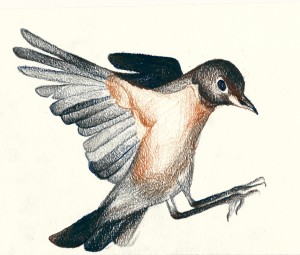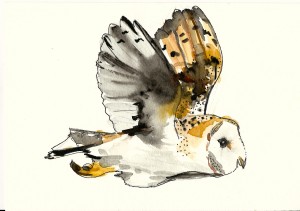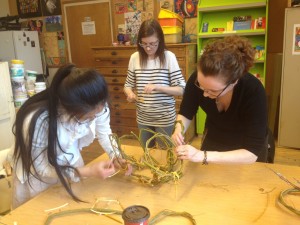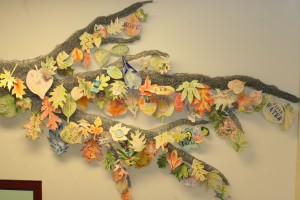We’re flapping again!ô A few years ago at OISE we did an eco-art project to raise awareness about the plight of migratory birds in urban environments as part of FLAPô – the Fatal Light Awareness Project.ô At that time I worked with my students to create over 300 handmade relief prints that were distributed to OISE offices to encourage faculty and staff to turn off their lights and close their blinds at night to reduce bird collisions with their windows.ô We had such a positive response to these prints that we’re working on FLAP 2.0 – an art installation to raise awareness for the rest of the institution.ô Working with our students, we’re in the process of making over a hundred watercolours of birds indigenous to south-western Ontario.ô These bird artworks are being scanned and printed onto a type of plastic/paper with an adhesive backing (made from 100% recycled plastic!), and then will be cut out to make life-sized bird stickers.ô They will be grouped into a huge flock in our walking art gallery (in the main stairwell), hopefully causing a FLAP when they are unveiled!ô Here are a few images that have been created so far…photos of full installation will be posted on my website early next summer.
Working with Willow
I had a Toronto artist, Morgan Zigler, do a workshop for my teacher candidates on working with willow in the spring; we had a great time! Itãs an easily-renewable, accessible, (often free) natural material to work with, making it just about as sustainable as it gets. We had a lot of fun learning the basics of working with willow, and making a few sculptures for the OISE Learning Garden ã a few photos of my students at work are below. Morgan has done a lot of this type of work at Evergreen BrickWorks, modelling how to use hands-on, experiential learning very effectively with youth; he has also done some great installations with using living willow in schoolyards.ô You can check out his website at:
http://foolishnature.org/homely/environmental/wood/wood.html
If you want to really take this to the zenith with your students, check out the work of Patrick Dougherty; he uses willow and other types of branches to create the most amazing natural architectural works!ô ô His website is beautiful in its own right, and contains lots of photos of his work:ô http://www.stickwork.net/ô Guaranteed to get any learner excited about the possibilities of working with willow!
Where Do Eco-Art Ideas Come From?
At the start of another new year at OISE, we are in planning mode to create a few new eco-artworks with our students.ô These projects have been well-received, and are successfully drawing attention to creating a culture of sustainability in our institution.ô We’ve been very lucky to have support from our CAO in this as she provides financial support to make them happen…it would be hard to make projects happen with no budget.ô But once the funding is in place, I’m often asked ‘where do you start’?ô How do you find the spark of inspiration that begins the creative process?ô I draw on a variety of sources for this – sometimes it comes from campaigns or organizations that are addressing an important environmental issue that we want to support.ô In other instances it has been a way to raise awareness about an issue we know is of concern to our organization specifically (our FLAP project is an example).ô Often it’s a technique or image from an existing artwork that inspires, triggering the reaction “I want to try that!” (This is a great way to push yourself to move beyond the art-making strategies you feel most comfortable with.)ô ô And at times it has been a request from someone in the organization to help to address a specific concern (aesthetic or environmental.)ô We’ve already got a project underway as an example of the latter; we were approached to provide new artwork for one of the busy meeting rooms in the building.ô This provided an opportunity to improve a space in the building aesthetically, and another way to get across the message about sustainability. This has translated into a series of large-scale photos of our Learning Garden, and will allow the garden to have a permanent, year-round presence inside the building.ô I’ll post photos of this installation here in the next few months as it is completed.
Using Digital Photos for Eco-Artmaking
Digital photography is a great technique to use for environmental art-making ã while itãs not ãno impactã (is anything?), it is low impact.ô For a small amount of electricity students can have so much fun taking photos and then modifying them in so many ways; itãs a great form of recycling!ô I have been using the work of many of environmental photographer/artists in my classroom as starting points for eco-art lessons.ô Canadian Ed Burtynsky is known internationally for his large-scale photos of human impact on the earth; if you havenãt seen his documentary Manufactured Landscapes, it is excellent viewing.ô I havenãt seen his newest one, called Watermark, but reviews of it are also strong.ô (More about his work at http://www.edwardburtynsky.com/ )ô The work of American photographer Peter Menzel is often found in my classroom as well ã his series Hungry World and Material World are fascinating portraits of familiesã consumption around the world; not surprisingly there are great disparities depending on where they live.ô I use his work to introduce eco-justice education and the power of art to raise awareness about inequity and its relationship to the environment.ô (http://www.menzelphoto.com/books/hp.php )ô And finally the work of American Chris Jordan (http://www.chrisjordan.com/gallery/rtn/#silent-spring ) is also useful to introduce how environmental statistics can have a greater impact when given visual form.ô ô Weãre experimenting with photography ourselves at OISE this summer by running a photography contest on our Learning garden – Iãll share the results in a future blog post.
Turning Over a New Leaf
How can you help your students turn over a new leaf when it comes to living more sustainably on the earth?ô I asked my pre-service students to do just that this year, and not surprisingly they gave a range of responses, from recycling to upcycling, to doing more with less, to hatching new ideas.ô This inspired their latest eco-art project, which has just been installed at OISE.ô I introduced them to the field of eco-art in a workshop, and then together we created over a hundred clay leaves that capture their ideas in both text and image, which were glazed and fired.ô Working with artist/student Angela Johnson, we created a large metal branch on which to hang the vibrant leaves.ô As this work hangs in our stairwell as part of the Take the Stairs energy conservation campaign, we hope that Turning over a new Leaf will help others think about how they can take positive change towards sustainability in their lives and those of their students, one step at a time!






